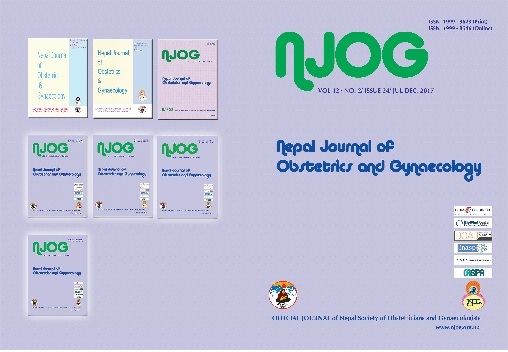Cesarean Delivery and its indication: a Cross Sectional Study in a Tertiary Care Hospital, Pokhara, Nepal
Keywords:
amniotic fluid index, fetal outcome, oligohydramniosAbstract
Aims: This study is done to see the maternal and fetal factors associated with isolated oligohydraminos.
Methods: It is a retrospective observational study done at Western Regional Hospital Pokhara. All cases of oligohydraminos except those with diabetes mellitus, hypertension, premature rupture of membranes, preterm labour and fetal congenital anomalies were included in the study. SPSS 16 and MS-Excel were used for data entry and analysis. Results were presented as graphs and tables.
Results: Sixty cases were enrolled in the study and the mean age was 25.6 years. Oligohydraminos was more prevalent among primigravida compared to multigravida (62% vs. 38%). Half of the women (n=30) delivered in between 37 to 40 weeks of gestation while 47% (n=28) of the women were post dates and two were post term. LSCS was the most common mode of delivery in this study (n=48). Anhydraminos was detected in seven women (12%) during caesarean section and rest had scanty liquor (41 in LSCS and 12 in vaginal delivery). One fifth of them (n=12) had low birth weight and there were no cases of growth retardation. Eighty two percent of women (n=49) had scanty clear liquor while only seven percent (n=4) had meconium stained scanty liquor. One had stillbirth and the rest had Apgar score of six or more including anhydramnios.
Conclusions: There were seven cases of anhydraminos and four cases of meconium stained liquor. All the live births had Apgar score of six or more. There was one stillbirth and neonatal admission each while no neonatal death in this study.
Downloads
Downloads
Published
How to Cite
Issue
Section
License
Copyright on any research article in the Nepal Journal of Obstetrics and Gynaecology is retained by the author(s).
The authors grant the Nepal Journal of Obstetrics and Gynaecology a license to publish the article and identify itself as the original publisher.
Articles in the Nepal Journal of Obstetrics and Gynaecology are Open Access articles published under the Creative Commons CC BY-NC License (https://creativecommons.org/licenses/by-nc/4.0/)
This license permits use, distribution and reproduction in any medium, provided the original work is properly cited, and it is not used for commercial purposes.



